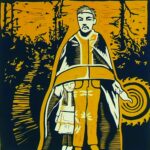Survivor Culture Exhibits
(sur·vi·vor cul·ture)
1. noun. Arts cultivated by those who live beyond psychiatric treatment.
Is art revolutionary? Highly political and intimate, Canadian survivor art flourished in the post-asylum era. For Tracey Mitchell, the curator who pulled this six-part exhibit together, the work was deeply personal. Join us inside the virtual gallery she created to see how expressions of mad culture have enriched our world.
Finding a Cultural History
 Survivor culture is not art therapy, or stories solicited for public education. It is the cultural expression of a quest for justice. Explaining that making this exhibit transformed both her understanding of mad community and her own identity, curator Tracey Mitchell argues that the personal and the political are inextricably connected in survivor culture. Visit Finding a Cultural History.
Survivor culture is not art therapy, or stories solicited for public education. It is the cultural expression of a quest for justice. Explaining that making this exhibit transformed both her understanding of mad community and her own identity, curator Tracey Mitchell argues that the personal and the political are inextricably connected in survivor culture. Visit Finding a Cultural History.
Still Sane
 Imagine encountering an exhibit of female figures, whose faces and bodies were inscribed with tales of psychiatric torture?
Imagine encountering an exhibit of female figures, whose faces and bodies were inscribed with tales of psychiatric torture?
This was Still Sane and the year was 1984. Fast forward twelve months, and Vancouver’s Press Gang publishers produced the book, taking the show’s feminist, lesbian and mad politics to a much wider audience. Visit Still Sane.
Shrink Resistant
 Shrink Resistant, recalls a time when there was a zeitgeist to make the hidden public, and for the disempowered to unit and take political action. Edited by Torontonians Bonnie Burstow and Don Weitz, the book was published in 1988 by New Star, Vancouver’s venerable left wing press. This was English Canada’s first collective representation of psychiatric survivors. Visit Shrink Resistant.
Shrink Resistant, recalls a time when there was a zeitgeist to make the hidden public, and for the disempowered to unit and take political action. Edited by Torontonians Bonnie Burstow and Don Weitz, the book was published in 1988 by New Star, Vancouver’s venerable left wing press. This was English Canada’s first collective representation of psychiatric survivors. Visit Shrink Resistant.
Call Me Crazy
 Call Me Crazy began with Irit Shimrat’s 1996 trans-Canada odyssey to gather the stories of key movement activists. Discovering that Shimrat still had the original cassette tapes from her interviews, After the Asylum had a selection of the archival recordings digitized, and asked the interviewees to share then and now photos and reflections on the current mad movement. Visit Call Me Crazy.
Call Me Crazy began with Irit Shimrat’s 1996 trans-Canada odyssey to gather the stories of key movement activists. Discovering that Shimrat still had the original cassette tapes from her interviews, After the Asylum had a selection of the archival recordings digitized, and asked the interviewees to share then and now photos and reflections on the current mad movement. Visit Call Me Crazy.
Crazymaking
 Learn from Indigenous artists about how they understand mental health, informed by colonial legacies and the need to heal. Coming out of an important 2007 residency at Gallery Gachet, an dissident outsider arts space, the art – and the artists – speak to the experience of living in an in-between place shaded by past trauma and strengthened by cultural heritage. Visit Crazymaking.
Learn from Indigenous artists about how they understand mental health, informed by colonial legacies and the need to heal. Coming out of an important 2007 residency at Gallery Gachet, an dissident outsider arts space, the art – and the artists – speak to the experience of living in an in-between place shaded by past trauma and strengthened by cultural heritage. Visit Crazymaking.
Maladjusted
 Meet a theatre crew who made their audience map out a way to humanize our broken mental health system. In 2013, Vancouver’s Theatre for Living launched Maladjusted, a production that crafted fictional scenarios from the lived experiences of cast members, using the stage as a platform to rehearse progressive changes to the current psychiatric regime. Visit Maladjusted.
Meet a theatre crew who made their audience map out a way to humanize our broken mental health system. In 2013, Vancouver’s Theatre for Living launched Maladjusted, a production that crafted fictional scenarios from the lived experiences of cast members, using the stage as a platform to rehearse progressive changes to the current psychiatric regime. Visit Maladjusted.
